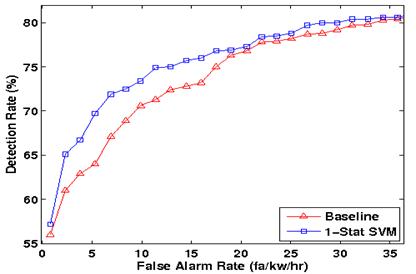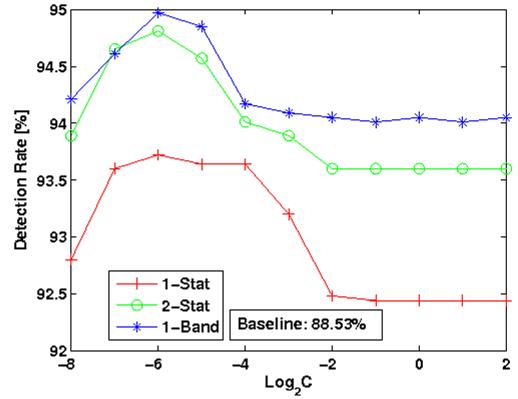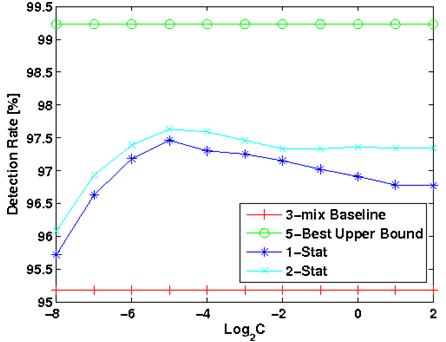MUSCLE Network of Excellence

Inventory of
Audio Description and Recognition Tools
Within the MUSCLE Network
of Excellence on
multimedia understanding, datamining and machine
learning
researchers have developed a range of tools for audio analysis, speech
recognition, sound description and music retrieval. This deliverable
(JPA3-DN 4.2 and JPA4-D4.1) of WP4 represents an inventory of current
audio feature
extraction, description and recognition tools: - RP_extract Music
Feature Extractor

- Audio
Feature Extraction Web Service

- Sound
Description Toolbox

- GenChords -
Automatic
Chord Detection

- Music Audio
Segmentation

- ARIA - Dynamics
Enhancement

- Bayesian
Extensions to Non-negative Matrix
Factorisation for Audio Signal Modelling

- Multi-Object
Tracking of Sinusoidal Components in Audio

- WinSnoori Speech Analysis Software
- Support Vector
Machine Re-Scoring Algorithm of Hidden Markov Models with Applications
to Speech Recognition

RP_extract
Music Feature Extractor 
TU Vienna - IFS, Thomas Lidy
Content-based access to audio files, particularly music, requires the development of feature extraction techniques that capture the acoustic characteristics of the signal, and that allow the computation of similarity between pieces of music. At TU Vienna - IFS three different sets of descriptors were developed:
- Statistical Spectrum Descriptors: describe fluctuations by statistical measures on critical frequency bands of a psycho-acoustically transformed Sonogram
- Rhythm Patterns: reflect the rhythmical structure in musical pieces by a matrix describing the amplitude of modulation on critical frequency bands for several modulation frequencies
- Rhythm Histograms: aggregate the energy of modulation for 60 different modulation frequencies and thus indicate general rhythmic in music
The algorithm considers psycho-acoustics in order to resemble the human auditory system. The feature extractor is currently implemented in Matlab and processes au, wav, mp3 and ogg files. Feature vectors are output in SOMLib format.
Download (V 0.621) : RP_extract_0.621.zip ![]()
Usage Guide: http://www.ifs.tuwien.ac.at/mir/howto_matlab_fe.html
Audio
Feature Extraction Web Service 
TU Vienna - IFS, Jakob Frank
The Audio Feature Extraction web service provides users the extraction of the features described above (Statistical Spectrum Descriptors, Rhythm Patterns, Rhythm Histograms) conveniently over the Web.After submitting audio data, the web service analyses the audio signal, extracts features and in turn provides the extracted descriptors as a file or stream. These can be used either in own local applications for audio and music similarity and the likes (classification, organization), but the Web Service furthermore also provides the possibility to generate Self-Organising Maps, which can be used for organization of musical content and for convenient access to music collections.
Besides allowing an immediate use of the web service with a Java Web Start application, we provide interfaces to the web service for developers, which can integrate the functionality in their own applications.
Details, direct access to the web service, and interface description:
http://www.ifs.tuwien.ac.at/mir/webservice/
Sound Description Toolbox 
AUTH
- AIIA, Emmanouil Benetos
The Sound Description Toolbox extracts a number of MPEG-7 standard descriptors as and other feature sets from WAV audio files. Features covered are:
- Energy: AudioPower
- Harmonic: AudioFundamentalFrequency
- Perceptual: Specific Loudness Sensation Coefficients
- Spectral: AudioSpectrumCentroid, Audio Spectrum Rolloff, AudioSpectrumSpread, MFCCs
- Temporal: Autocorrelation Coefficients, Log-attack Time, TemporalCentroid, Zero-crossing rate
- Various: AudioSpectrumFlatness
Download: SoundDescriptionToolbox.zip
![]()
GenChords -
Automatic
Chord Detection 
TU Vienna - IFS, Veronika Zenz
We have designed an automatic chord detection algorithm that operates on musical pieces of arbitrary instrumentation and considers music theoretical knowledge. Our detection method incorporates rhythm and tonality of the musical piece the same as knowledge about the common frequencies of chord-changes. An average accuracy rate of 65% has been achieved on a test set of 19 popular songs of the last decades and confirms the strength of this approach.The GenChords chord-detector consists of 4 modules: The basic chord detection itself, beat tracking, key detection and a chord-sequence optimizer. Beat tracking is used to split the audio data into blocks of sizes that correspond to the computed beat structure. As chord changes usually happen on beat times, beat detection is a good method to enlarge analysis blocks without risking to miss chord-changes. Each of the obtained blocks is passed to an enhanced autocorrelation-algorithm. Its output is then used to compute the intensity of each pitch class, the so called Pitch Class Profile (short PCP). The calculated PCP's are compared to a set of reference chordtype-PCP's using only those reference chords that fit to the key of the song. Finally the smoothing algorithm rates each chord according to the number of chord changes around it.
Details: http://www.ifs.tuwien.ac.at/mir/chorddetection.html
Download (C++ source code): genchords.zip
Music Audio
Segmentation 
TU Vienna - IFS, Ewald Peiszer
Automatic audio segmentation aims at extracting information on a songs structure, i.e., segment boundaries, musical form and semantic labels like verse, chorus, bridge etc. This information can be used to create representative song excerpts or summaries, to facilitate browsing in large music collections or to improve results of subsequent music processing applications like, e.g., query by humming. This algorithm performs 2 phases:Phase 1: Boundary detection
This phase tries to detect the segment boundaries of a song, i.e., the time points where segments begin and end. The output of this phase is used as the input for the next phase.
Phase 2: Structure detection
This phase tries to detect the form of the song, i.e., a label is assigned to each segment where segments of the same type (verse, chorus, intro, etc.) get the same label. The labels themselves are single characters like A, B, C, and thus not semantically meaningful.
Details: http://www.ifs.tuwien.ac.at/mir/audiosegmentation.html
Download: ep_audiosegmentation-2007-07-30.zipARIA - Dynamics
Enhancement 
CNR-ISTI, Graziano
Bertini
ARIA - DDS is a new methodology of sound processing,
able to rebuild
the dynamic freshness of the recorded music. With ARIA every sound in
the mix will be pushed in evidence, reducing the sense of "flatness" we
often meet in today's commercial recordings. ARIA allows to perceive
the music structure and "groove" also at relative low volumes, where
usually standard way of playback fails, sounding poor and
uninteresting. ARIA is based on a special algorithm, which recognizes
and enhance the dynamic sound variations at the various audio spectrum
frequency bands. Only quite fast variations and peaks are altered,
following special rules: in this way the overall timbre is not changed
as often happens in common exciters or dynamic expanders.
Details:
http://www.aria99.com
Download demo: dsp_aria.zip
Contact: aria_dsp@yahoo.it
Bayesian
Extensions to Non-negative Matrix
Factorisation for Audio Signal Modelling 
Cambridge University, Tuomas Virtanen, Ali-Taylan Cemgil, Simon Godsill
Non-negative matrix factorisation is applied here as a decomposition where spectrogram matrix X is approximated as a product of excitation matrix E and template matrix V. It is an efficient machine learning tool that can be applied in audio signal analysis in supervised or unsupervised manner. Bayesian extensions of the method enable assigning priors for the parameters. In the case of templates V, they allow defining prior information about spectra of sources and when used for excitations E, they can model correlation between adjacent frames, or sparseness of the excitations.
The software package contains non-negative matrix factorisation algorithms targeted for the analysis audio signals. It contains an implementation of the algorithms by Lee and Seung [1], which minimise either the Euclidean distance or the divergence function. It also contains extensions, which include sparseness or temporal continuity terms [2]. Bayesian extensions described in [3] which enable setting priors for the matrices to be estimated are implemented in the package as well. It also includes algorithms for minimising two other reconstruction error measures which are based on the probabilistic models described in [4].
[1] D. D. Lee, H. S. Seung. Algorithms for non-negative matrix factorization, Advances in Neural Information Processing Systems, 2001.[2] T. Virtanen. Monaural Sound Source Separation by Non-Negative Matrix Factorization with Temporal Continuity and Sparseness Criteria, IEEE Transactions on Audio, Speech, and Language Processing, vol. 15, no. 3, March 2007.
[3] T. Virtanen, A. T. Cemgil, and S. J. Godsill. Bayesian Extensions to Non-negative Matrix Factorisation for Audio Signal Modelling, ICASSP 2008.
[4] T. Virtanen and A. T. Cemgil. Bayesian extensions to Non-negative Matrix Factorisation using Gamma Chain Priors. Technical report, Cambridge University, October 2007.
Instructions: All the algorithms in the package can be used by calling the Matlab function nmffactorize which can be found in the file nmffactorize.m. The help text of the function explains its usage.
Download: nmf-audio.zip
Further information about the algorithms in the package can be obtained from Simon Godsill or Taylan Cemgil.
Multi-Object
Tracking of Sinusoidal Components in Audio 
Cambridge University, Daniel Clark, Ali-Taylan Cemgil, Paul Peeling, Simon Godsill
The tracker identifies individual sinusoidal tracks from audio signals using multi-object stochastic filtering techniques. It can estimate target states when observations are missing and can maintain the identity of these targets between time-frames. The objective to find parameters of a set of damped sinusoidals is achieved through a multi-object generalisation of Bayes filtering. The Probability Hypothesis Density Filter is a recursion of the first-order moment of the multi-object Bayes filter.
This is an example of the tracker, which has been programmed for a two-dimensional constant velocity model. The library is not restricted to this case and can be used for other models and different dimensions. The algorithm is described in the following papers:
- D. E. Clark, K. Panta, V. Ba-Ngu (2006) The GM-PHD Filter Multiple Target Tracker. Proc. International Conference on Information Fusion, Florence, Italy, pp. 1-8.
- D. Clark, A. T. Cemgil, P. Peeling, and S. Godsill (2007) Multi-object tracking of sinusoidal components in audio with the Gaussian mixture probability hypothesis density filter. Proc. of IEEE Workshop on Applications of Signal Processing to Audio and Acoustics, pp. 339-342.
./tracker
Download: tracker.zip
Further information about the algorithms in the package can be obtained from Simon Godsill or Daniel Clark.
WinSnoori Speech Analysis Software
INRIA-Parole, Yves LaprieUsing tools for investigating speech signals is an invaluable help to teach phonetics and more generally speech sciences. For several years we have undertaken the development of the software WinSnoori which is for both speech scientists as a research tool and teachers in phonetics as an illustration tool. It consists of five types of tools:
- to edit speech signals,
- to annotate phonetically or orthographically speech signals. WinSnoori offers tools to explore annotated corpora automatically,
- to analyse speech with several spectral analyses and monitor spectral peaks along time,
- to study prosody. Besides pitch calculation it is possible to synthesise new signals by modifying the F0 curve and/or the speech rate,
- to generate parameters for the Klatt synthesiser. A user friendly graphic interface together with copy synthesis tools (automatic formant tracking, automatic amplitude adjustment) allows the user to generate files for the Klatt synthesiser easily.
In the context of speech sciences WinSnoori can
therefore be exploited for many purposes, among them, illustrating
speech phenomena and investigating acoustic cues of speech sounds and
prosody.
Download (V 1.34-03): WinSnoori_1.34_setup.exe
Details
and Guide: http://www.loria.fr/~laprie/WinSnoori/index.html
Support
Vector Machine Re-Scoring Algorithm of Hidden Markov Models with
Applications to Speech Recognition 
Tel-Aviv University ( TAU – SPEECH), A. Sloin, A. Alfandary, D. Burshtein
According to the statistical approach to automatic speech recognition, each linguistic unit is typically assigned a hidden Markov model (HMM), the parameters of which are estimated using the Maximum Likelihood (ML) approach. However, when the assumed model is not sufficiently accurate or when there is not enough training data, it is possible to significantly improve the recognition rate using discriminative training methods, such as support vector machine (SVM)-type classification. In our work we proposed a new SVM re-scoring algorithm of HMMs with applications to speech recognition. This algorithm utilizes a variable to fixed length transformation of the speech data. The application of the algorithm to isolated and connected digit and word-spotting tasks provides a significant error rate reduction compared to standard ML-trained HMM systems.
Figure 1 shows a comparison between our method and standard ML training (baseline) on a noisy isolated digit task (TIDIGITS database). The error rate reduction is 56.1% compared to the baseline.
For a connected digit experiment we obtained a reduction of 51% in the error rate. This is shown in the figure 2.
|
Figure 1 |
Figure 2 |
Figure 3 shows the ROC curves of the baseline and new approaches for a keyword spotting task.

Figure 3
Software: The research programs for the tasks described above (isolated speech, connected speech and word spotting) can be obtained by contacting David Burshtein (available to MUSCLE members only).
Related Journal Publications:
- A. Sloin and D. Burshtein, “Support Vector Machine Training for Improved Hidden Markov Modeling,” IEEE Transactions on Signal Processing, vol. 56, no. 1, pp. 172-188, January 2008.
- A. Alfandary and D. Burshtein, “Improvements and Generalization of the SVM Re-Scoring Algorithm of Continuous HMMs”, to be submitted to IEEE Transactions on Signal Processing.


